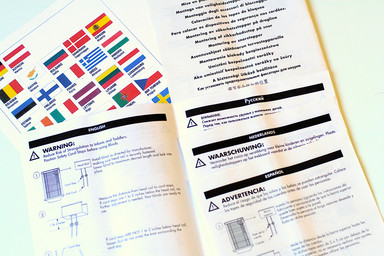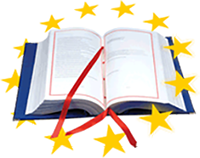Technical translations... instruction manual

Translating technical specifications for products and industrial services
 Technical Translation of User Guides
Technical Translation of User Guides

Let's continue our instructive reading of the Council of Europe Resolution on translations.
In our previous article, we highlighted just how strongly the recommended best practices related to the design of technical manuals make the case for structured writing systems.
What about managing the content to be translated?
Still making multilingual technical manuals?
Manual writing language
Consumers have easy access to instruction manuals created at the very least in their own official EU language, in a readable, easy-to-understand fashion. For the sake of clarity and to facilitate their use, various linguistic versions are presented separately from each other.
 Multilingual translation: Technical translation must be clear, personalized, easy to read
Multilingual translation: Technical translation must be clear, personalized, easy to read
All too often, we still see multilingual user manuals with up to twenty languages on a single document! Two points are made to justify this:
-
"practical" reasons. A single document, a single captioned diagram in every language;
-
logistical reasons. At the time it is being packaged, we do not know the reader's nationality...).
However, it is best that these practices end! Two main reasons:
-
Environmental best practices, to limit the amount of paper needlessly wasted, which will go directly into the waste bin upon unpacking...
-
A better user experience (UX). Even in this regard, marketing recommendations should not be overlooked. To be simpler, faster, more direct, more practical: so many key user comfort elements that contribute product differentiation and a sure competitive advantage, no matter the product...
The manufacturers of the Smartphone, for example, understood this, playing with the complementarity of multiple medias. They reduced their printed documentation to the most basic and redirected the user to documentation available on line, directly in the proper language, and at times, multimedia.
Favoring simple technical writing
Communicating information
Communicating information preferably meets the following requirements:
-
paying sufficient attention to clarity and precision,
-
paying attention to spelling and grammar,
-
using understandable terminology,
-
using, as much as possible, active voice rather than passive voice,
-
avoiding the needless use of specialized terms,
-
using up-to-date expressions,
-
showing coherence in the use of terms (in other words, the same term should always be used to designate the same object or the same action),
-
using fonts that avoid any confusion between upper-case and lower-case letters and numbers,
-
explaining abbreviations in plain text,
-
when illustrations are used, make sure they correspond exactly to those seen by the consumer, only contain necessary information and only represent a single new informational element per illustration,
-
when symbols are used, make sure they correspond to commonly used pictograms, are easily recognizable and always have the same meaning,
-
when a combination of text and illustrations is used, choose one of the two to always represent the main information media,
-
do not use images without text, because that does not ensure clarity, images alone are not always sufficiently clear.
Most of these recommendations speak for themselves. It's common sense...that should not be overlooked. Even though this clarity is often not sought-after or respected!
Simultaneous management of images and text: an XML tool like Calenco to the rescue!
The last point, however, would have deserved to be deepened: do not stick to images without text. It is always problematic to manage images that contain text or that are associated to text, when they must be translated.
Luckily, an existing tool, such as Calenco, based on XML, allows separation of content from its layout, such as images and their caption.
Key advantage : multilingual content management that can explain or caption visuals in a way that is not onlyfaster, but also more reliable!
Conclusion: structured writing in the service of technical writers.. as well as for users!
This Resolution of the Counsel [of Europe] thus represents an excellent user manual for the user manual! A condensed list of best practices for technical writers.
If its implementation in 1998 may have seemed delicate, a structured writing tool like Calenco now allows all writers toeasily implement all of these recommendations.
Through its software platform dedicated to structured technical writing,NeoDoc has been developing tailor-made solutions to simplify, optimize and safeguard the work of user guides technical writers and translators for more than 12 years. By putting the user at the heart of writing, the solutions draws on the fundamentals of technical writing and structured writing. Because facilitating access to the right information for the user also adds value to the product and solidifies the client relationship.




